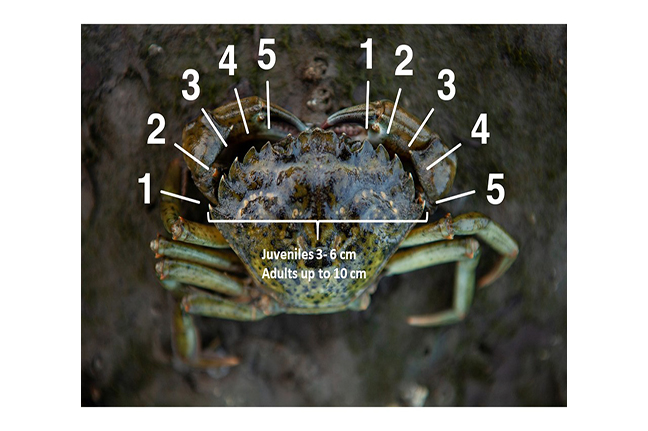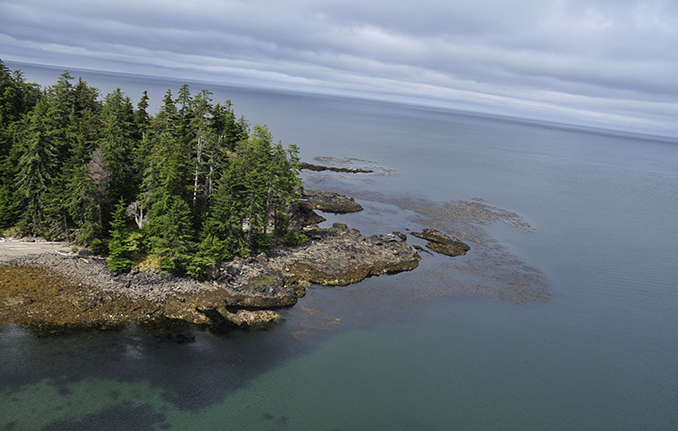Getting a Foothold in North Beach
Terri J. Bell, CHN Marine Planning —
It’s five in the morning and my blaring alarm wakes me up. I shoot out of bed; my heart is racing as if I’d had a bad dream. Sleepy-eyed, I drag my feet to the kitchen to make a fresh pot of coffee. Something you should know about me – I don’t just like coffee, I love it – I get excited at night thinking about the first cup in the morning. Standing at the sink I filled the pot with coffee grains and water, but to my dismay, the darn coffee pot decided not to work that morning. Nevertheless, at 5:45 I am on the road driving from Daajing Giids Queen Charlotte to Tllgaay Gaauu North Beach to take in the k’aamahl razor clam stock assessment with the Haida Fisheries team.
Did you know?
The Haida Fisheries Program has been conducting k’aamahl surveys on Tllgaay Gaauu since 1994, two years after the Aboriginal Fisheries Strategy (AFS) was first implemented. The AFS strategy is funded by Department of Fisheries and Oceans Canada (DFO) and supports First Nations management of fisheries, such as stock assessment, fish enhancement and issuing communal fishing licenses. The commercial razor clam fishery is unique because unlike the regular commercial licences, the right to access cards are issued by the Council of the Haida Nation (CHN) and Haida Fisheries issues “razor clam designation cards” to fishers. About 200 cards were issued this year with the annual commercial harvesting quota set just above 500,000 lbs – an increase from the previous year’s quota of 404,000 lbs.
In Gaaw Masset, I meet up with Stu Crawford, the Council of the Haida Nation’s Marine Ecosystem-based Management Monitoring Coordinator and we drive to Tllgaay Gaauu to rendezvous with the Haida Fisheries team. Driving onto the beach I was surprised to see many trucks dotted along the sandy beach which stretched all the way to Rose Spit. I immediately thought that given it was so early, “Haida must really love their razor clams!”. I learned that while razor clams are an important food source, the diggers on the beach were harvesting the clams most likely to be sold as bait for the crab fishery.

A sampling ring is pushed into the sand and Yalthkunung Christopher Collison uses the ‘stinger’, a nozzle that shoots pressurized sea water from a water pump into the sand. The process liquefies the sand causing the clams to float to the surface. A dip net is then used to collect the clams.
Photo: Terri J. Bell, CHN Marine Planning.
The first sample began on the upper beach, two hours before low tide. I didn’t want to admit to anyone that I had absolutely no idea what a k’aamahl looked like and as I watched the stinger placed into the sampling ring, like little popcorn kernels the razor clams began to shoot up to the surface. From the slurry, I picked up and held my first razor clam, and pushing the gritty sand aside the golden-brown rings of the shell were revealed. We take three clams from each station, 15 metres apart, and we sample down the beach until we hit the low tide mark.
“The transect is run from the high tide mark towards the low, this way we get an idea of how the clams are stratified along the beach,” shellfish biologist GidKunis Daniel McNeill explains. I assist GidKunis by recording the time, sample set, and the number of clams found within that sample.

A team of four to six is required to run a k’aamahl survey. Fisheries Technicians, Yalthkunung Christopher Collison, Sqiila Brandon Bell, Skaamsang Dagwiiyaa Jaad Brenna Smith work with Marine Ecosystem-based Management Monitoring Coordinator, Stu Crawford and Communications Outreach Intern, Terri J. Bell.
Photo: GidKunis Daniel McNeill, Haida Fisheries Program

Comparing the stages of growth from young to adult. Those under 5mm are put back in the sand.
Photo: GidKunis Daniel McNeill, Haida Fisheries Program.
Did you know?
When the water temperature reaches 55 degrees Fahrenheit; during the summer months, the male and female k’aamahl reproduce by broadcast spawning. The k’aamahl deposit millions of minuscule sperm and eggs into the ocean water. After fertilization, the eggs develop into free-swimming larvae, and within five to six weeks the larvae develop into juvenile clam which then settle on the beach floor, digging deeper as they grow. Their growth rate slows down during the winter months and accelerates during the summer months as plankton flourishes. Within two years the k’aamahl growth rate slow down to conserve energy for reproduction. The razor clam can live up to eighteen years.

Marine Ecosystem-based Management Monitoring Coordinator, Stuart Crawford, records the weight and shell length of each k’aamahl. The shells are labeled and stored, with the intent to analyze the shells rings at a later date.
Photo: Terri J. Bell, CHN Marine Planning
After a cold and windy day on the beach we travel back to the Haida Fisheries warehouse in Gaaw to record the weight, size and sample set onto a data sheet which will be used to analyze and estimate the abundance and biomass of the razor clam to set next year’s quota.
Even with an increase in this year’s quota, the amount of razor clams being harvested is less than the set quota. In 2015, the quota was 404,000 lbs but only 233,873 lbs were harvested.
“Overall, I would say the fishery has been managed sustainably and the future looks promising,” McNeill comments.
At the end of the shift, I was given a bag of slimy, bald, k’aamahl and headed over to Sherri’s Gas Bar and Grill with some of the fisheries team. Without hesitation, I ordered a large cappuccino, it’s delicious combination of bitter and sweet warmed me up while I eagerly waited for the fresh clam chowder. K’aamahl is so delicious!
Terri J. Bell is an intern with the BC Aboriginal Youth Internship program and has been working with the CHN Marine Planning Program for the past several months. She was raised in Oliver BC, surrounded by lakes, mountains, and dry desert grass.



0 Comments